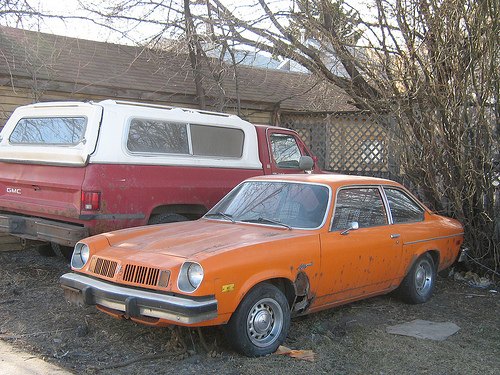Editorial: General Motors Death Watch 257: Paul Niedermeyer's GM Obit

How do you write an obituary for an entity that’s been dead for seventeen years? Like that high-school Biology frog-leg experiment, GM’s twitching since 1992 was due to externally administered stimuli. Yes, I would have much preferred to write GM’s obit in ’92. Back then, the guilty party was merely GM’s brain-dead management. It would have been easy just to rag on about all the lame cars they built. But it’s become a lot more complicated and uglier. Now we all have blood (and red ink) on our hands. And it’s not going to wash out easily.
While we rub on our damn spots, let’s refresh our short collective memory. In 1992, GM posted a $23.5 billion loss, coming off multi-billion dollar losses the year before. It was the culmination of GM’s most disastrous decade ever. Market share collapsed from 45 percent in 1980, to 34 percent in 1989. Share price was down 90 percent from its all-time (adjusted) peak of $358 in 1965. GM’s bonds lost their vaunted AAA rating. The whiff of bankruptcy was in the air. If only the plug had been pulled then. It would have spared us all hundreds of billions and untold agony, not to mention well over 250 General Motors Death Watches.
Up to ’92, it was pretty much all GM’s own (un)doing too, from Astre to John Z . DeLorean. Nobody else to blame. Well, mostly, anyway. Some of the “artificial stimulus” had already begun, in the form of 1981’s Japanese (not at all) Voluntary Export Restraints (VER) deal. Denial and the blame-game were high on GM’s agenda, and curbing Japanese imports was going to fix Detroit. It turned into a classic example of “be careful of what you wish for.”
The Japanese responded with higher prices, and reinvested the resulting outsized profits in Lexus and Marysville, Ohio, among others. Is that what the Motown boyz had in mind when they beggared Washington for relief? And who paid for it all? The consumer, of course. Japanese car prices jumped some 15 to 30 percent during the VER era; Detroit’s, not. Somebody was paying for the development costs of that Caddy-killing Lexus LS400.
The Lexus was overkill anyway; by 1985, the pathetically-shrunken Cadillac DeVille was just a mutated Chevy Celebrity. This self-inflicted damage was mortal, too. GM’s premium brands had been their money printing press since the 1920s. Reel in the consumer in with a cheap Chevy, but make the killing when they trade up.
GM could live with Ford or Plymouth getting into Chevy’s pants once in a while, as long as Mercury, Edsel, Lincoln, DeSoto and Chrysler kept their hands off their “golden girls.” Having managed to keep them chaste for decades, they proceed to royally fuck themselves with ugly look-alike dwarves in 1985. I could go on (and have), but need I say more to explain GM’s death as an auto-maker in 1992?
Going forward from 1992 is an oxymoron. Since the mid eighties, the domestic automobile industry, as well as much of the domestic economy, has been all too heavily influenced by government policy, or the lack of it. What might have seemed good for the US might have also seemed good for GM, but . . .
Let’s call the lack of political will to implement a steadily rising gas tax to curb demand and stimulate long-term investment in an appropriate (and stable) fleet mix of vehicles Exhibit A. Alan Greenspan’s repeated downward pressure on interest rates in the face of both the stock bubble of the late 90’s and the subsequent real estate bubble makes Exhibit B.
The explosion of the financial sector due to the low interest rates and the lack of regulation or enforcement is “C.” American’s eagerness to slurp up the resulting brew of over-leveraged mini-MacMansions and oversized SUV’s with which to make their forty-mile commute is Exhibit D.
The end result: an epic F.
This unsustainable potion of cheap gas and cheaper money created the Zombie Three, with GM at the head of the pack. Even during those boom SUV years, GM’s cost structure and low transaction prices on cars resulted in profits from vehicles that were dismal, at best. In a decent year, like 1996, GM’s North American operations had a 0.8 percent return. What profits GM booked during these past seventeen years were primarily from financing and whatever overseas operations were having a good run, for the moment.
Yet investors were still willing to pay $100/share for a company that couldn’t make a profit on a car. Artificial stimulus indeed.
Meanwhile, it’s no secret that Toyota and Honda were generating around 70 to 90 percent of their global profits out of the US market alone. By building cars and light trucks.
Reality’s last hope would have been C11 in 1992, restructure oppressive union contracts, and hire Roger Penske to vacuum “ the tubes” from top to bottom. Oh, and a tax-stabilized price of gas. And a genuine, effective national health care policy. And a responsible financial industry. And a functioning regulatory system. And awake consumers. And . . . so much for wishful thinking.
The inconvenient truth: for decades, GM has not been an automaker, but a wealth and capital-destroying dragon. Some $200 billion dollars in equity has been wiped out. Throw in another $27 billion in debt gone tits-up, as well as “your” contribution of some $45 billion: well over a quarter trillion dollars up in smoke. Where’s Saint George when we need him?
There was a time when we just said goodbye or good riddance to our failed companies. Studebaker was once the biggest wagon maker in the land. No more. Now we’re incapable of killing GM, and it’s too late to genuinely revive it. Just think up some new (electric) stimulus to keep it twitching.
It’s a waste of time and energy to blame GM for anything it’s done, or not, since its real death in 1992. Rick Wagoner’s immutable face is just another mask in our national tragedy play. Even worse, he’s what we see when we look in our collective mirror. In Pogo’s immortal words: “We have met the enemy, and he is us.”

More by Paul Niedermeyer
Latest Car Reviews
Read moreLatest Product Reviews
Read moreRecent Comments
- Merc190 I would say Civic Si all the way if it still revved to 8300 rpm with no turbo. But nowadays I would pick the Corolla because I think they have a more clear idea on their respective models identity and mission. I also believe Toyota has a higher standard for quality.
- Dave Holzman I think we're mixing up a few things here. I won't swear to it, but I'd be damned surprised if they were putting fire retardant in the seats of any cars from the '50s, or even the '60s. I can't quite conjure up the new car smell of the '57 Chevy my parents bought on October 17th of that year... but I could do so--vividly--until the last five years or so. I loved that scent, and when I smelled it, I could see the snow on Hollis Street in Cambridge Mass, as one or the other parent got ready to drive me to nursery school, and I could remember staring up at the sky on Christmas Eve, 1957, wondering if I might see Santa Claus flying overhead in his sleigh. No, I don't think the fire retardant on the foam in the seats of 21st (and maybe late 20th) century cars has anything to do with new car smell. (That doesn't mean new car small lacked toxicity--it probably had some.)
- ToolGuy Is this a website or a podcast with homework? You want me to answer the QOTD before I listen to the podcast? Last time I worked on one of our vehicles (2010 RAV4 2.5L L4) was this past week -- replaced the right front passenger window regulator (only problem turned out to be two loose screws, but went ahead and installed the new part), replaced a bulb in the dash, finally ordered new upper dash finishers (non-OEM) because I cracked one of them ~2 years ago.Looked at the mileage (157K) and scratched my head and proactively ordered plugs, coils, PCV valve, air filter and a spare oil filter, plus a new oil filter housing (for the weirdo cartridge-type filter). Those might go in tomorrow. Is this interesting to you? It ain't that interesting to me. 😉The more intriguing part to me, is I have noticed some 'blowby' (but is it) when the oil filler cap is removed which I don't think was there before. But of course I'm old and forgetful. Is it worth doing a compression test? Leakdown test? Perhaps if a guy were already replacing the plugs...
- Crown No surprise there. The toxic chemical stew of outgassing.
- Spamvw Seeing the gear indicator made me wonder when PRNDL was mandated.Anyone?Anyone?1971


































Comments
Join the conversation